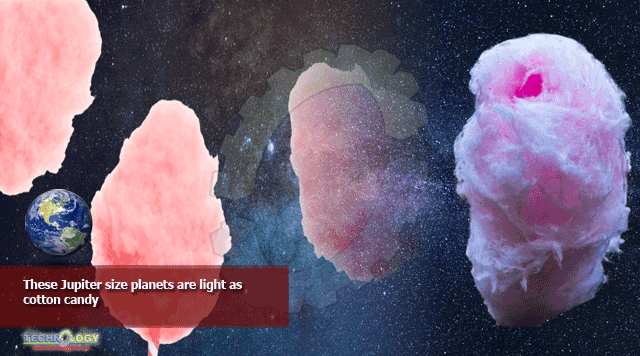Astronomers as soon as believed that the majority photo voltaic programs can be very like our personal, with cotton candy small rocky planets close to their solar,

A ccompanied by fuel giants orbiting the star at larger distances. Starting in 1992, researchers started to search out worlds orbiting alien stars, and shortly discovered photo voltaic programs got here in all kinds of formations.
Immediately, astronomers know of greater than four,000 worlds orbiting different stars. Of those, 15 have exceedingly low densities, decrease than that of cotton sweet.
Three of those planets — dubbed super-puff worlds — are discovered within the Kepler 51 star system, 2,600 gentle years from Earth. Bigger than the dimensions of Jupiter, these planets comprise lower than one p.c of the mass of the biggest planet in our photo voltaic system.
Kepler 51 d (closeup) with Kepler 51 C within the background, as it might seem close to closest method between the 2 worlds. Picture credit score: The Cosmic Companion | Created in Universe Sandbox
These super-puff worlds have densities lower than zero.1 grams per cubic centimeter. By comparability, the density of Earth is round 55 occasions larger, at round 5.5 grams per cubic centimeter. Jupiter weighs in at round 1.33 grams per cubic centimeter, whereas Saturn (the least-dense planet in our solar system) checks in simply shy of zero.7 grams per cubic centimeter.
“We knew they had been low density. However once you image a Jupiter-sized ball of cotton sweet — that’s actually low density,” mentioned Jessica Libby-Roberts, a graduate pupil within the Division of Astrophysical and Planetary Sciences (APS) on the College of Colorado Boulder.
A take a look at how the three recognized planets orbiting Kepler 51 evaluate in measurement to the planets of our personal photo voltaic system. Picture credit score: NASA/ESA/STScI
Utilizing the Hubble House Telescope, her group discovered one thing uncommon — the atmospheres of these worlds was not clear as they anticipated —the air surrounding these cotton candy was lined in an obscuring haze.
“We noticed two transits every of Kepler 51b and 51d with the Vast Area Digicam three (WFC3) on the Hubble House Telescope. Combining new WFC3 transit occasions with re-analyzed Kepler knowledge and up to date stellar parameters, we confirmed that each one three planets have densities decrease than zero.1 [grams per cubic centimeter],” researchers reported in The Astronomical Journal.
Using laptop simulations and different instruments, the group decided these fluffy worlds are largely composed of hydrogen and helium, which fill the ambiance with low-mass materials, decreasing the density of the worlds. at excessive altitudes, the air comprises methane. When this fuel encounters ultraviolet gentle, it varieties a haze, much like the one seen on Titan, the biggest moon of Saturn.
“It positively despatched us scrambling to give you what could possibly be happening right here. We anticipated to search out water, however we couldn’t observe the signatures of any molecule,” Libby-Roberts defined.
Presently, astronomers know of three exoplanets orbiting Kepler-51. Kepler 51-b and c had been found in 2012, and Kepler 51-d was first noticed two years later. Every of those worlds orbits considerably nearer to their solar than the Earth does across the Solar — between one-quarter and one half of the Earth-Solar distance. The NASA video beneath exhibits a take a look at how the Kepler and Tess spacecrafts seek for worlds round different stars.
These super-puff worlds had been additionally discovered to be shedding their atmospheres to house, the group discovered. The innermost of those worlds, Kepler 51-b, is regarded as dropping tens of billions of tons of its ambiance to the void of house ever second. At that charge, this cotton candy will lose its puffiness over roughly one billion years. After that point, the world will resemble a smaller model of the planet Neptune, researchers decided.
The star round which these worlds orbit, Kepler 51, has about the identical mass and temperature as our Solar, however is barely 90 p.c of the dimensions of our native star. By comparability, this trio of worlds have plenty a couple of occasions larger than the Earth, and orbit their stars in a matter of months.
This analysis means that these bizarre super-puff planets could also be frequent in younger photo voltaic programs.
If planets resembling cotton sweet weren’t sufficient, astronomers additionally not too long ago revealed a massive candy cane close to the middle of the Milky Method galaxy. It’s a candy time for astronomy.
This text was initially printed on The Cosmic Companion by James Maynard, founder and writer of The Cosmic Companion. He’s a New England native turned desert rat in Tucson, the place he lives along with his beautiful spouse, Nicole, and Max the Cat. You’ll be able to learn this authentic piece here.
Astronomy News with The Cosmic Companion can be out there as a weekly podcast, carried on all main podcast suppliers. Tune in each Tuesday for updates on the newest astronomy information, and interviews with astronomers and different researchers working to uncover the character of the Universe.
This news was originally published at bestgamingpro.com